
In its Financial Stability Report, the Central Bank of the UAE said average residential sale prices had surged by 24 per cent in Dubai and 21 per cent in Abu Dhabi for the year.
Rental yields in Dubai and Abu Dhabi have dipped below historical levels as property prices continue to rise, leading the UAE Central Bank to caution that they could indicate a growing imbalance.
In its Financial Stability Report 2013, released on Sunday, the Central Bank of the UAE said average residential sale prices had surged by 24 per cent in Dubai and 21 per cent in Abu Dhabi for the year. Rental yields in both emirates slipped below eight per cent.
“Current average rental yields in Dubai and Abu Dhabi are approximately 70 basis points (bps) and 130bps below historical averages [respectively], which could indicate growing imbalances [and an] overheating real estate market,” the central bank said.
However, it noted, growth in bank loans were stable, unlike the sharp rise that had accompanied the previous upswing for property in 2008.
Decreasing yields had so far been concentrated in areas with the greatest price rises, and nearly all freehold developments were demonstrating higher growth rates than the city average, the report said.
The indicators suggested non-GCC citizens, equity and external funding sources were driving the property price rises. Monitoring the UAE real estate market’s development and banks’ exposure to it remained a core financial stability priority, the central bank said.
Commenting on the report, Mat Green, head of research and consultancy UAE, CBRE Middle East, said new regulations in the property sector were helping it steadily progress towards maturity.
“Government intervention to curb speculative buying activity is already apparent,” Green said.
It was hoped that these recent regulatory changes, together with the Dubai Land Department’s doubling of transfer fees on property sales, would help hold down speculation and allow Dubai’s real estate sector to see more sustained growth in the long term, he said.
Last month, the IMF asked Dubai to take stronger measures to curb speculation in the property market.
Green said the sheer volume of new project launches in the residential market was once again becoming a point of concern, though as yet the actual delivery of new supply had not reached a point where demand was being rebalanced.
“Significant investment is again taking place in the off-plan segment, with investors enticed by the attractive payment plans, with many offering low initial deposits and back ended structures which are allowing more people to enter the market,” he said.
“With a flurry of project announcements and renewed investment activity, the market should, quite rightly, be cautious of overheating.”
According to the central bank report, deviations of rental yields from long term averages were commonly used to identify imbalances in the housing market and were considered to be a reliable indicator of the state of the property cycle.
But an alternate measure — subtracting the Emirates Interbank Offered Rate — was a better indicator for property as a pure investment option. Taking that view, the decline in rental yields over the last three years were comparable to the decline in returns in the money market, it said.
Bank finance for the purchase of residential property increased by 12 per cent in 2013 or by Dh12.7 billion, indicating that banks were increasingly participating in financing the real estate recovery. But the funds provided by the banking sector was only enough to finance the purchase of less than 30 per cent of the residential properties that were completed in 2013.
Economic recovery continues to take place with GDP having grown by five per cent at constant prices in 2013, according to IMF recent estimates.


